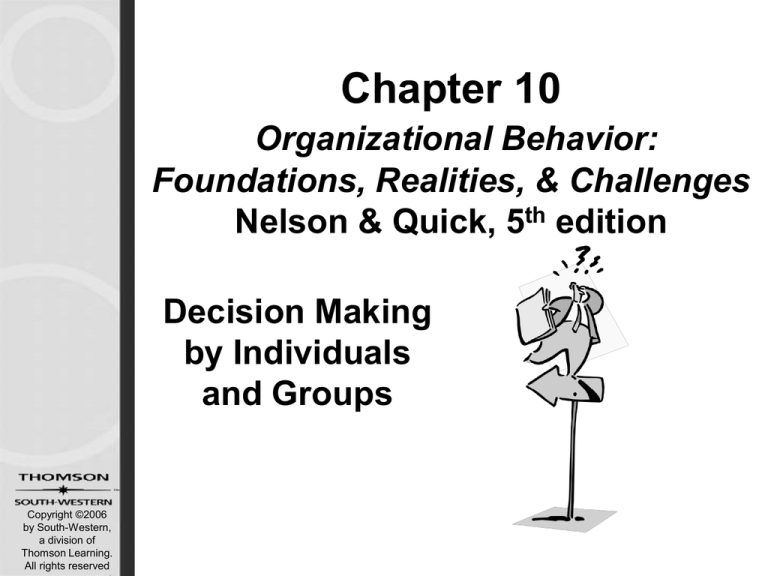
Chapter 10
Organizational Behavior:
Foundations, Realities, & Challenges
Nelson & Quick, 5th edition
Decision Making
by Individuals
and Groups
Copyright ©2006
by South-Western,
a division of
Thomson Learning.
All rights reserved
The Decision-Making Process
Programmed Decision –
Nonprogrammed Decision –
Copyright ©2006
by South-Western,
a division of
Thomson Learning.
All rights reserved
The
DecisionMaking
Process
Recognize . . .
Identify . . .
Gather and evaluate . . .
List and evaluate . . .
Copyright ©2006
by South-Western,
a division of
Thomson Learning.
All rights reserved
The
DecisionMaking
Process
Select . . .
Implement . . .
Gather . . .
Follow up
Copyright ©2006
by South-Western,
a division of
Thomson Learning.
All rights reserved
Models of Decision Making
Effective
Decision
Definition:
Rational Model
Bounded Rationality
Model
Garbage Can Model
Copyright ©2006
by South-Western,
a division of
Thomson Learning.
All rights reserved
Rationality –
Rational Model
1.
2.
3.
4.
Copyright ©2006
by South-Western,
a division of
Thomson Learning
All rights reserved
Bounded Rationality –
Bounded Rationality
Model
1.
2.
3.
4.
Copyright ©2006
by South-Western,
a division of
Thomson Learning
All rights reserved
Bounded Rationality –
Bounded Rationality
Model
Satisfice –
Heuristics –
Copyright ©2006
by South-Western,
a division of
Thomson Learning
All rights reserved
Garbage Can Model
Solutions
Problems
Choice
opportunities
Participants
Garbage Can Model –
Copyright ©2006
by South-Western,
a division of
Thomson Learning
All rights reserved
From M.D. Cohen, J.G. March, and J.P. Olsen in Administrative Science Quarterly 17 (March 1972) 1.25.
Reprinted by permission of the Administrative Science Quarterly
Risk and the Manager
Risk Aversion –
Risk takers
---Copyright ©2006
by South-Western,
a division of
Thomson Learning.
All rights reserved
Evidence:
Escalation of
Commitment
The tendency to continue
to commit resources to a
failing course of action
• Why it occurs
----• How to deal with it
Copyright ©2006
by South-Western,
a division of
Thomson Learning.
All rights reserved
----
Cognitive Style
Cognitive Style –
Jungian theory offers a way of
understanding and appreciating
differences among individuals.
Copyright ©2006
by South-Western,
a division of
Thomson Learning.
All rights reserved
Jung’s Cognitive Style
Style
ST
Sensing/thinking
SF
Sensing/feeling
NT
Intuiting/thinking
NF
Intuiting/feeling
Copyright ©2006
by South-Western,
a division of
Thomson Learning.
All rights reserved
Ideal Organization
Z Problem-Solving Model
Look at
the facts
and details
Can it be
analyzed
objectively?
Copyright ©2006
by South-Western,
a division of
Thomson Learning.
All rights reserved
?
?
?
What alternatives
do the facts
suggest?
?
What impact
will it have on
those involved?
Figure from Type Talk at Work by Otto Kroeger and Janet M. Thuesen. Copyright © 1992 by Otto Kroeger
and Janet M. Thuesen. Used by permission of Dell Publishing, a division of Random House. Inc.
Two Brains, Two Cognitive Styles
Left Hemisphere
Copyright ©2006
by South-Western,
a division of
Thomson Learning.
All rights reserved
Right Hemisphere
Ideal =
From Left Brain, Right Brain by Springer and Deutsch © 1989, 1985, 1981 by Sally Springer and Georg Deutsch.
Used with permission by W.H. Freeman and Company
Influences on Decision
Making
Intuition –
Copyright ©2006
by South-Western,
a division of
Thomson Learning.
All rights reserved
Creativity –
Four Stages of Creative Process
Preparation
Incubation
Copyright ©2006
by South-Western,
a division of
Thomson Learning.
All rights reserved
Illumination
Verification
Influences on Creativity
• Individual examples
– Cognitive Processes
• Organizational
examples
---
– Personality Factors
--
Copyright ©2006
by South-Western,
a division of
Thomson Learning.
All rights reserved
Four Types of Creativity
because it is
expected of
you in your job
You respond to
problems
You discover
problems
Copyright ©2006
by South-Western,
a division of
Thomson Learning.
All rights reserved
because you want
to be creative
Participative
Decision Making
Individuals who are
affected by decisions
influence the making
of those decisions
• Organizational Foundations
–
–
• Individual Prerequisites
–
–
–
Copyright ©2006
by South-Western,
a division of
Thomson Learning.
All rights reserved
Group Decision Making
• Role of synergy –
• Role of social decision schemes –
Majority Wins
Truth Wins
Two-thirds Majority
Copyright ©2006
by South-Western,
a division of
Thomson Learning.
All rights reserved
First-shift
Group Decision Making
1.
Advantages
2.
3.
1.
Disadvantages
2.
3.
Copyright ©2006
by South-Western,
a division of
Thomson Learning
All rights reserved
Group Phenomenon
Groupthink –
Group Polarization –
Copyright ©2006
by South-Western,
a division of
Thomson Learning.
All rights reserved
Preventing Groupthink
1.
2.
3.
4.
5.
6.
Copyright ©2006
by South-Western,
a division of
Thomson Learning.
All rights reserved
From Janis, Irving L., Groupthink: Psychological Studies of Policy Decisions and Fiascoes, Second Edition. Copyright
© 1982 by Houghton Mifflin Company.
Group
Decision
Techniques
Copyright ©2006
by South-Western,
a division of
Thomson Learning.
All rights reserved
Technological Aids to
Decision Making
Expert Systems –
Decision Support Systems –
Group Decision Support Systems –
Copyright ©2006
by South-Western,
a division of
Thomson Learning.
All rights reserved
Decision Making in the
Virtual Workplace
Copyright ©2006
by South-Western,
a division of
Thomson Learning.
All rights reserved
Ethics Check
• Is it legal?
--• Is it balanced?
--• How will it make me feel about myself
Copyright ©2006
by South-Western,
a division of
Thomson Learning.
All rights reserved







